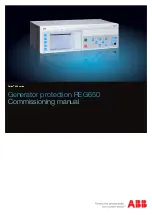
Event block name
Event names
FRQV1
f<< Trip ON
FRQV1
f<< Trip OFF
FRQV1
f<<< Start ON
FRQV1
f<<< Start OFF
FRQV1
f<<< Trip ON
FRQV1
f<<< Trip OFF
FRQV1
f<<<< Start ON
FRQV1
f<<<< Start OFF
FRQV1
f<<<< Trip ON
FRQV1
f<<<< Trip OFF
FRQV1
f> Block ON
FRQV1
f> Block OFF
FRQV1
f>> Block ON
FRQV1
f>> Block OFF
FRQV1
f>>> Block ON
FRQV1
f>>> Block OFF
FRQV1
f>>>> Block ON
FRQV1
f>>>> Block OFF
FRQV1
f< Block ON
FRQV1
f< Block OFF
FRQV1
f<< Block ON
FRQV1
f<< Block OFF
FRQV1
f<<< Block ON
FRQV1
f<<< Block OFF
FRQV1
f<<<< Block ON
FRQV1
f<<<< Block OFF
The function registers its operation into the last twelve (12) time-stamped registers. The table below
presents the structure of the function's register content.
Table. 5.4.13 - 138. Register content.
Date and time
Event
f Pre-trig (Hz)
f Fault (Hz)
Used SG
dd.mm.yyyy hh:mm:ss.mss
Event name
Start/Trip –20ms frequency
Fault frequency
Setting group 1...8 active
5.4.14 Rate-of-change of frequency (df/dt>/<; 81R)
The rate-of-change of frequency function is used to detect fast drops or increases in frequency. If the
load changes fast this function detects and clears the frequency-based faults faster than conventional
underfrequency and overfrequency protections. One of the most common causes for the frequency to
deviate from its nominal value is an unbalance between the generated power and the load demand. If
the unbalance is big the frequency changes rapidly.
Genera
Generattor Commander
or Commander
Instruction manual
Version: 2.07
© Arcteq Relays Ltd
IM00001
159
Содержание Generator Commander
Страница 1: ...Generator Commander Instruction manual...
Страница 2: ......













































